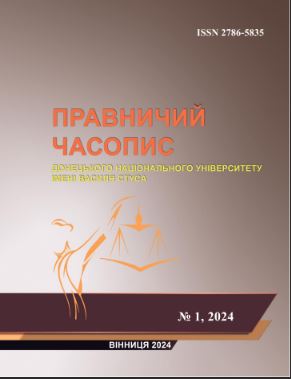Some Issues of the Objective Side of Fraud Committed Through Illegal Operations Using EOT
DOI:
https://doi.org/10.31558/2786-5835.2024.1.22Keywords:
criminal law, criminal responsibility, fraud, objective party, deception, non-cash money, electronic computing equipmentAbstract
The issues of determining the content of the signs of the objective side of fraud committed through illegal transactions using electronic computing equipment are considered. Deception is characterized as a key feature of such fraud. Both judicial decisions and provisions of the science of criminal law are taken into account, and a number of debatable issues are analysed. Argumentation is provided for the possibility of considering as deception in the context of criminal liability for fraud (Article 190 of the Criminal Code) the communication of false information to a non-victim person (not to the owner of a bank account, but to a banking institution). It is proven that deception in such cases may consist in reporting false data not directly to employees of banking institutions (for example, cashiers), but be mediated by means of computer technology used by the banking institution (payment terminal, ATM, specialized website, etc.). Such deception is proposed to be called indirect.
Features of the objective side of this type of fraud are defined as follows: the guilty person fraudulently induces the issuing bank to perform actions that were not authorized by the legal card holder. First, by sending an unauthorized payment request and using an existing payment system, the attacker misleads the bank about the need to fulfil the obligations under the contract with the legal holder. Secondly, due to this delusion, the bank unjustifiably debits the funds from the account of the legal holder, causing him losses. Thirdly, the actions of the criminal in initiating the transfer of funds and the specified harmful consequences are in a cause-and-effect relationship.
In the event that an unauthorized transaction is made in virtual assets, indirect fraud also occurs. Broadcasting to the network of nodes that ensure the functioning of the payment system of virtual assets, a message with the initiation of a transaction signed by the private key of the victim, the guilty person deceives the participants of the payment system of virtual assets. Such deception consists in reporting false information that the person who owns the virtual asset initiates a transaction of his asset.
References
Shapochka S. Preventing Fraud Using Computer Networks. Internal Security. 2013. № 2. P. 70.
Вирок по справі № 523/7978/17 від 22.07.2018. Суворовський районний суд м. Одеси. URL: https://reyestr.court.gov.ua/Review/72548283 (дата звернення: 08.05.2024).
Вирок по справі № 589/1156/18 від 03.04.2023. Шосткинський міськрайонний суд Сумської області. URL: https://reyestr.court.gov.ua/Review/109985005 (дата звернення: 11.05.2024).
Дудоров О. О. Проблеми кваліфікації шахрайства. Матеріали Міжнародної науково-практичної Інтернет-конференції «Політика в сфері боротьби зі злочинністю». Івано-Франківськ, 2014. С. 21–32. URL: http://law-dep.pu.if.ua/conference2014/articles/dudorov.pdf (дата звернення: 04.05.2024).
Ємельянов М. В. Кримінально-правова характеристика шахрайства: автореф. дис. … канд. юрид. наук: 12.00.08. Київ, 2013. 19 с.
Карчевський М. Особливості кваліфікації злочинів проти власності, що вчиняються з використанням комп’ютерної техніки. Підприємництво, господарство і право. 2012. № 1. С. 139–142.
Кримінальне право України: Особлива частина: підручник / Ю. В. Баулін, В. І. Борисов, В. І. Тютюгін та ін.; за ред. В. В. Сташиса, В. Я. Тація. 4-те вид., переробл. і допов. Харків: Право, 2010. 608 с.
Музика А. А., Азаров Д. С. Законодавство України про кримінальну відповідальність за «комп’ютерні» злочини: науково-практичний коментар і шляхи вдосконалення. Київ: Вид. Паливода А. В., 2005. 120 с.
Панов М. М. Кримінальна відповідальність за незаконні дії з документами на переказ, платіжними картками та іншими засобами доступу до банківських рахунків: монографія; наук. ред. В. І. Борисов. Харків: Право, 2009. 184 с.
Постанова Касаційного кримінального суду Верховного Суду від 07.02.2019 № 489/4597/14-к. База даних правових позицій Верховного суду. URL: https://lpd.court.gov.ua/adjudication/56 (дата звернення: 12.05.2024).
Усманов Р. А. Шахрайство з використанням електронно-обчислювальної техніки: аналіз судової практики. Науковий вісник Львівського державного університету внутрішніх справ. Серія юридична. 2024. № 1. DOI: 10.32782/2311-8040/2024-1-19 (дата звернення: 14.05.2024).

